About half an hour after visiting the Culoo Rock area, we encountered the same man walking his dog who told us about St. Brendan’s Well. He started gesturing wildly and pointing to a gigantic hill in the centre of the Island. I understood very little of what he was saying during this conversation… and only managed to catch “difficult walk,” “petting zoo,” and “radio tower.”
Again, we drove in the general direction that this man gestured towards using the “radio tower” as a guide. About 10-minutes later we found the entrance to the Fogher Cliffs. This is the highest point on Valentia and views from here are phenomenal. On a good day you’re able to see the Skellig Islands, the Blasket Islands, Portmagee, and Macgillycuddy’s Reeks.
Be warned, however, this is the windiest place I have ever been. I used to refer to the Bay of Fundy as the windiest place in the world… and then I went to Sutro Baths in San Francisco. Sutro was quickly displaced by the Rock of Cashel as the wind champion. However, all of these places are simply drafty compared to the mighty winds of the Fogher Cliffs. I took very few photos because I was afraid my heavy, clunky camera would blow away like a piece of paper!
One of the neat things about the walk to the edge of the Fogher Cliffs is numerous large placards with the Irish tales of the Fianna displayed upon them. So, as you are walking and enjoying the view, you can read the tales that take place in the various landmarks you are viewing. I’ve transcribed these legends and put them below the photo gallery.
The Fianna
According to the ancient bardic King lists, Slaigne of the Firbolgs was the first High King of Ireland in 1934 BC. From then until 1175 AD there were 188 High Kings, the last of whom was Ruaraidh O Conchobhair who signed the Treaty of Windsor in October 1175 AD accepting Henry II of England a Suzerain of Ireland. At around 200 BC Fiachadh was High King and he founded the Fianna. They were a band of warriors who guarded him and whose main duty was guarding the ports of Ireland against invasion. They consisted of 25 battalions of 27 men and were a military elite.
The Salmon of Knowledge
2nd Century AD — Cumhail was the leader of the Fianna. When he was killed in battle his wife Muirne put their son, Fionn Mac Cumhail, into hiding to protect him from his father’s enemies. As a young boy, he was sent to study under a druid (teacher, poet, judge) called Finnegas. The druid’s goal in life was to catch the elusive ‘Salmon of Knowledge’ from the river Boyne. It was said that the first person who ate the salmon would know everything there was to know in the world. Finally, one-day Finnegas caught the salmon with a spear.
While Fionn was cooking the fish he burned his thumb and sucked it, thus acquiring great knowledge. From then on, he only had to put his thumb in his mouth and he knows the answer to every question. With this new knowledge, Fionn set out on his adventures and saved the life of the High King, Cormac Mac Art by killing a dragon and as a result was made leader of the Fianna. The stories of Fionn’s adventures with the Fianna are called the ‘Ossianic Cycle’ and date to the 3rd Century AD.
The Goddess of the Lake
Fionn had a son, Oisin who grew to be a great warrior, married Eibhir and they had a son called Oscar. One morning while the Fianna were hunting on the shores of Lough Leane, a goddess rode out of the lake. It was Niamh of the Golden Hair from Tír na nÓg (Land of Eternal Youth) declaring: “I have come for Oisin, son of Fionn.”
Though already married, Oisin fell in love and leaped onto her horse. They rod off into the Lough to Tír na nÓg where they were very happy. Oisin stayed there for what felt like 3 weeks, but in fact, it was 300 years as he didn’t age. He missed Ireland and wanted to go back. Niamh warned him to stay on his horse and not set foot on Irish soil. Oisin returned to Ireland, arriving in from the sea at Rossbeigh, climbed to Bealach Oisin to look into Glencar for the hunting Fianna. But Fionn and his friends were long dead and the Fianna gone. He was surprised at how weak the people had become and leaned from his horse to help some men to push a rock. The girth of his saddle broke and he fell to the ground, immediately becoming an old wizened man and died.
The Battle of Fionn’s Strand
While Oisin was in Tír na nÓg with Niamh, back in Ireland Fionn got into his own trouble! While on a trip to France, he wooed the wife and daughter of the French King! Fionn brought them back to Ireland and the King was outraged. He called on the King of the World, Daire Donn to come to his assistance to get them back. In all, 20 Kings came to Ireland and landed at Ventry on the Dingle Peninsula (12 miles across the bay from here [the Fogher Cliffs]). Their fleet was so great that it choked the mouth of Dingle Bay.
A battle ensued known as Cath Fionntragha (Battle of Fionn’s Strand) in Ventry. Fionn overcame his enemies and killed Daire Donn in one of the great military exploits of his career. During that battle, Oscar (Oisin’s son) threw a rock from Ventry which landed at Fogher Gate in the clifftop, 200 metres from where you are standing [the Fogher Cliffs]. This rock was known as “Oscar’s Cast” and the rock here is a full-size replica. No one knows how or when Fionn died, maybe he is not dead but sleeping in a cave waiting for the call to help Ireland in her hour of need.
The Fianna’s Final Battle
Oscar was now the mightiest warrior of the Fianna with a heart “like a twisted horn sheathed in steel.” He was given command of a battalion called “The Terrible Broom” because it would not retreat but swept its enemies from the field. He led the Fianna in the Battle of Gabhra near Dublin in 280 AD against Cairbre the High King who was seeking to curb the Fianna’s power. The battle saw the destruction of the Fianna. Oscar killed Cairbre but was mortally wounded himself. Oscar’s wife, Aidin died of grief. Fionn and Oisin came from the “Otherworld” to lament him and carry his bier with the hero Celta.
And that is the story of the Fianna.

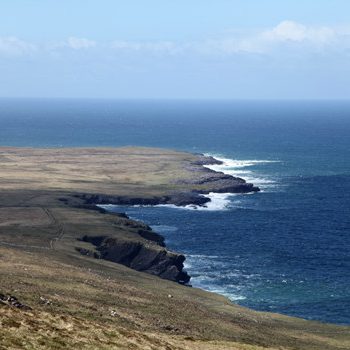
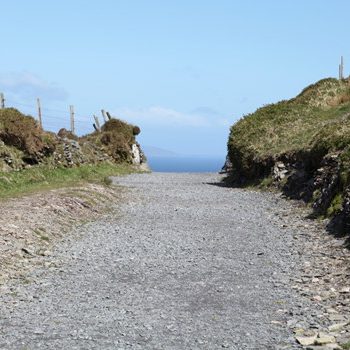
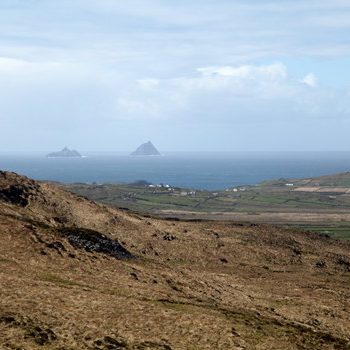
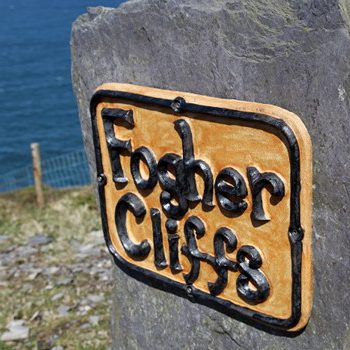
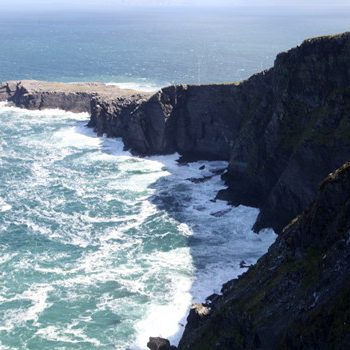
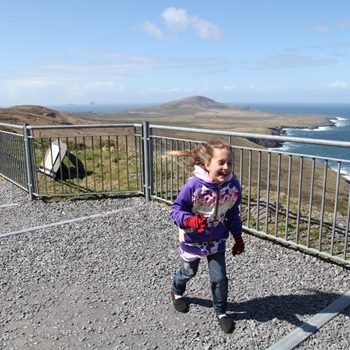
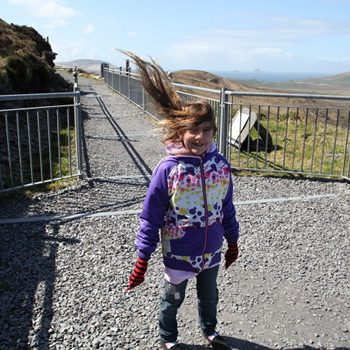
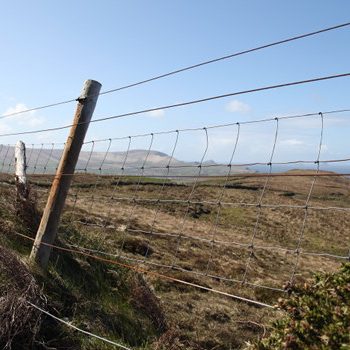
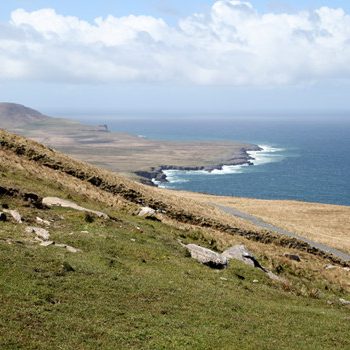
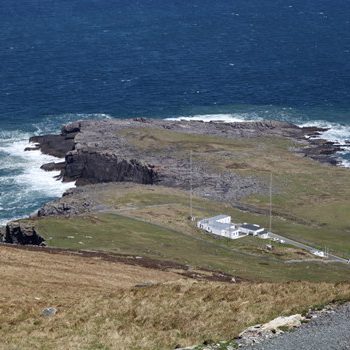
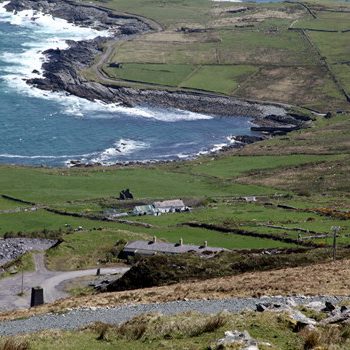
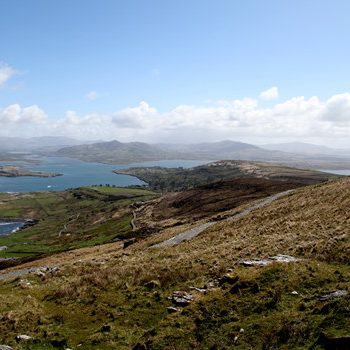
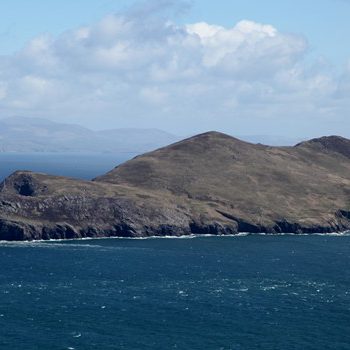
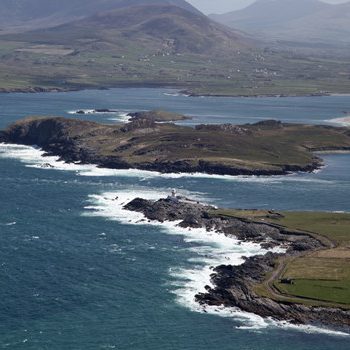
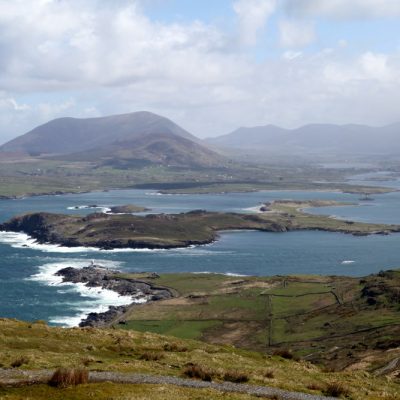
0 comments on “Geokaun Mountain and Fogher Cliffs”Add yours →